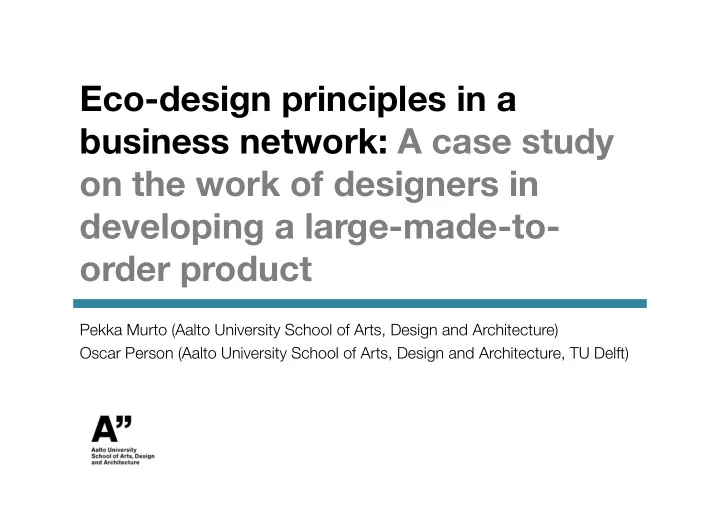

Eco-design principles in a business network: A case study on the work of designers in developing a large-made-to- order product � Pekka Murto (Aalto University School of Arts, Design and Architecture) Oscar Person (Aalto University School of Arts, Design and Architecture, TU Delft)
Introduction: business networks Products developed increasingly in business networks (Ford et al. 2011; Möller • et al. 2004; Jarillo 1993) Optimal combination between vertical integration and outsourcing • – Focus on core competence & collaborate to produce complete offerings – Individual actors cannot control everything in the network Company Offering Comp any Comp Comp any any Murto & Person: Eco-design in a business network / CADMC 2013
Introduction: eco-design Eco-design often suggested to require wide and early application already in • concept design (e.g. ISO 2011; Lewis et al. 2001; Blizzard & Klotz 2012) – Similar to consistency and strategic use of design as in design management (Cooper and Press 1995; Stevens and Moultrie 2011) Individual actors should ideally be able to control their partners and supply • chain Company Offering Comp any Comp Comp any Ideal scope of eco-design any Murto & Person: Eco-design in a business network / CADMC 2013
Eco-design in business networks? Eco-design � Individual � business � focus/ideal � scope � focus/control � 1. How do eco-design principles stand out in business networks? 2. What is the role of designers in realising eco-design in business networks? Murto & Person: Eco-design in a business network / CADMC 2013
Method Case study (work in progress) • – 17 interviews with product developers working in a project • 10 designers, 5 managers, 2 coordinators – Process documents and public documents used as supportive material Large-made-to-order (LMTO) metal product • – E.g. power plants, offshore equipment, ships (see Stoyell et al. 2001) – Collaboration and networked development with multiple different specialists – Major sustainaiblity improvemets targeted and achieved in the project (mostly energy-related) ”Dyad-network perspective” (as in Halinen & Törnroos 1998) • – Focus on manufacturer and client Murto & Person: Eco-design in a business network / CADMC 2013
Method Interviews fully transcribed, analysed and coded: • – When did the designers/developers work in the project? – What tasks and roles they performed? – How the environmental targets influenced their work? Murto & Person: Eco-design in a business network / CADMC 2013
Results
Results Roles and tasks in different stages compared � – Phase 1 focus on sales and a wide range of concepts • Style, function. service, technology, sustainability… • Generic focus on sustainability, i.e. ”suggestions” – Phases 2 and 3 more focused on realisation “…we try to lure the client with “…it’s a long journey and good ideas and pictures right there’s many processes in from the start” between. But if you’re lucky and make a good suggestion or idea […] it can go all the way to the end.” Murto & Person: Eco-design in a business network / CADMC 2013
Results However, no linear sequence between Phases 1,2 and 3 • – Designers coming in at later phases start again with their own concepts (with cost level determined and feasibility expected) – Contractual reasons and work ownership ”I go through them [concepts “One consultant made this kind from P1] and I met the designer of a proposal and we started also […] but we didn’t go about negotiating from that […] about realising them in any way, it what it should then actually actually be was not feasible” like, so that we can manufacture it” Murto & Person: Eco-design in a business network / CADMC 2013
Results Influence of environmental targets to design � Designers aware and interested in sustainability issues of the product but • detached from eco-design and sustainability improvements – Focus on core design competences, i.e. appearance and function (as in e.g. Ulrich and Eppinger, 2000) – Safety constrains as a barrier to more sustainable material selection In comparison engineers heavily influenced by the targets • “so the reality is quite, it's like “ [the sustainability focus of the there's so many safety issues project] did not really, in terms before that [sustainability] you of the environment, bring have to think about”. anything to the design, so that we would have somehow emphasized environmental friendliness in it” Murto & Person: Eco-design in a business network / CADMC 2013
Conclusions Principles of wide and early eco-design application diffcult in business • networks – Early design concepts not decisive in the studied case (translatability more relevant) – No linear progression from P1 to P2 to P3 (instead multiple different concept design phases) In the studied case, designers did not play a key role in eco-design • – Focus on core competence in business networks – Design work mostly untouched by energy-related issues Yet, significant environmental improvements achieved • – The collaborative nature of business networks as a key success factor in sustainability improvements? • Client problems become manufacturer problems Murto & Person: Eco-design in a business network / CADMC 2013
Implications Design managers must develop sensibility towards who specifically to manage • in eco-design and when? – Translation of ideas to practice a key moment, not the earliest possible concepts – Some product developes more influential in eco-design Focused environmental improvements that can survive from idea to execution • should be targeted – Design managers should aid to bridge the gap between early vision concepts and production concepts Murto & Person: Eco-design in a business network / CADMC 2013
Limitations LMTO-products are unique • – Different industries and product types developed in business networks need to be studied to draw wider conclusions Interviews as reflections on events rather than factual accounts of events • (Silverman 2011) – Ethnographic studies may reveal deeper insights – Interviewees in different project stages during the time of interview due to long lead time Murto & Person: Eco-design in a business network / CADMC 2013
Thank you! Murto & Person: Eco-design in a business network / CADMC 2013
Recommend
More recommend